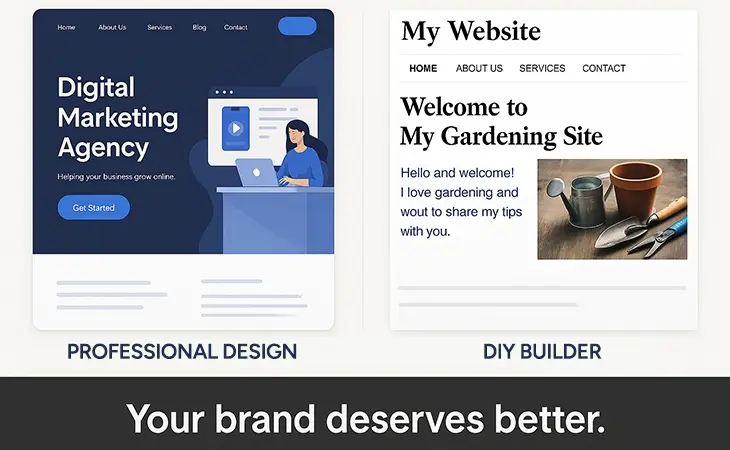In the age of digital entrepreneurship, the allure of DIY site builders is undeniable. Designed to empower individuals and small businesses, platforms like Wix, Squarespace, and WordPress promise a world of creative freedom at our fingertips. However, beneath the glossy surface, these tools often present challenges that can leave users feeling frustrated and misled. In this article, we delve into the seductive charm of DIY site builders while revealing the hidden pitfalls that many users encounter along the way.
Unpacking the Allure of DIY Site Builders Today
The rise of DIY site builders can be traced back to a fundamental human desire for independence and self-expression. Consider Sarah, a budding entrepreneur who launched her handmade jewelry business online. With little technical knowledge, she was drawn to the idea of building her own website in just a few clicks. Armed with templates and drag-and-drop functionality, she felt a rush of empowerment as she customized her site to her liking. This story echoes the experiences of countless others who have embraced this newfound freedom.
Another significant factor in the allure of DIY site builders is their affordability. Compared to hiring a professional web developer, which can cost thousands, these platforms offer budget-friendly subscriptions that fit the constraints of many startups. With plans starting as low as $10 a month, entrepreneurs can create a digital presence without breaking the bank. However, the question remains: what do users sacrifice for this perceived value?
User-friendly design is another major selling point. Today’s DIY site builders boast intuitive interfaces that make web design accessible to anyone, regardless of their technical background. For instance, a recent study found that over 70% of users reported finding website creation easier than they anticipated. The promise of instant gratification draws in users, encouraging them to dive headfirst into the world of online presence.
The availability of templates is also a significant draw. With a myriad of styles to choose from, users can quickly find a design that resonates with their brand. For many, the ability to select a pre-designed layout that aligns with their vision is a game-changer. However, while templates provide a starting point, they can also limit creative expression, leading eventually to a site that feels generic and uninspired.
Moreover, the marketing strategies employed by these platforms often gloss over the challenges. Bold claims of "create a website in minutes" and "no coding needed" create a tempting narrative that can be hard to resist. As a result, many users leap into the DIY sphere without fully understanding the complexities involved. In this rush, they may overlook critical elements such as SEO optimization and mobile responsiveness, which can impact their site’s success.
Finally, the community aspect of DIY site builders enhances their appeal. Many platforms offer forums and support networks that foster a sense of belonging among users. Entrepreneurs like Sarah often find solace in sharing their experiences, troubleshooting issues, and celebrating milestones together. This camaraderie can be empowering; however, it can also perpetuate the myth that anyone can achieve online success without professional guidance.
The Hidden Costs: What You Don’t See at First Glance
While the initial appeal of DIY site builders is compelling, the hidden costs can accumulate quickly, often leaving users in a bind. One of the most significant hidden expenses is the time investment required to create and maintain a website. For instance, Sarah initially took pride in her website’s aesthetics but soon found herself overwhelmed by the ongoing need for updates, maintenance, and troubleshooting. The reality is that DIY site building is not a one-and-done affair; it requires continual attention.
Furthermore, users often underestimate the implications of scalability. Many DIY platforms offer limited features and functionalities that may not accommodate growth. When Sarah’s jewelry business began to gain traction, she quickly realized that her chosen platform could not support the advanced features she needed, such as e-commerce integration and robust analytics. This forced her to either compromise on her vision or start the arduous process of migrating her website to a more capable platform.
Search engine optimization (SEO) is another area where hidden costs lurk. While DIY site builders often claim to be SEO-friendly, the reality is that many users lack the expertise to optimize their sites effectively. In Sarah’s case, despite hours spent customizing her site, she struggled to appear in search results, ultimately affecting her site traffic and sales. The lack of visibility can be a silent killer for any online business, yet many users remain unaware of the intricacies involved in ranking higher on search engines.
Additionally, many DIY platforms incorporate transaction fees and other hidden charges that can eat into profits. For small business owners like Sarah, any additional costs can be detrimental to their bottom line. Transparency is often lacking, and users may only discover these financial pitfalls after they have committed to a platform. It’s essential for potential users to read the fine print and be aware of all potential charges before diving in.
Another hidden cost comes in the form of limited customer support. While many DIY site builders tout their customer service, the quality often falls short, particularly during high-demand periods. When Sarah encountered a technical issue during a critical sales event, she found herself waiting hours for assistance—a frustrating reality that could have dire consequences for her business. A lack of timely support can leave users feeling stranded and unable to resolve issues that affect their online operations.
Lastly, the emotional toll of navigating a DIY site can lead to burnout. The initial excitement can quickly morph into frustration as users grapple with unexpected challenges. For Sarah, the joy of building her brand turned into a stressful endeavor that threatened her passion for jewelry-making. It’s crucial for aspiring web creators to recognize this emotional cost and consider whether the DIY route aligns with their long-term goals.
Navigating the Pros and Cons of DIY Website Solutions
The journey through the world of DIY site builders is often a double-edged sword, with both advantages and disadvantages at play. On the positive side, the financial savings associated with these platforms can be substantial. For those just starting, the prospect of launching a website with minimal upfront costs is enticing. However, as we’ve seen, this advantage may diminish over time as users encounter hidden fees and the need for advanced features.
Additionally, the creative control offered by DIY site builders is a significant plus. Users like Sarah revel in the ability to customize their site according to their unique vision. Yet, this same freedom can lead to decision fatigue, where the sheer number of options becomes overwhelming. The paradox of choice can hinder creativity rather than foster it, leaving users unsure of the best path forward.
Another pro is the speed at which users can get their sites up and running. For many entrepreneurs, time is of the essence, and the ability to launch a website quickly can be invaluable. However, the impulsive nature of this speed can result in hasty decisions that may hinder long-term success. It’s essential for users to balance speed with strategic planning to ensure their website aligns with their business goals.
When it comes to support, DIY site builders often provide a wealth of resources, from tutorials to community forums. This can be a boon for those seeking guidance. However, as mentioned earlier, the quality of customer service can be inconsistent and may leave users feeling unsupported when they need it most. For entrepreneurs like Sarah, having reliable support is crucial—especially during critical moments.
The scalability of DIY site builders is a mixed bag. For small businesses just starting, the simple solutions they provide can be sufficient. Nevertheless, as businesses grow, users may find themselves constrained by the platform’s limitations. Transitioning to a different platform later on can be a daunting task, requiring significant time and effort. Users must consider their long-term plans before committing to a particular service.
Lastly, the emotional aspect of DIY website creation cannot be ignored. The thrill of crafting a digital space can be exceptionally rewarding, but the stress of troubleshooting and ongoing maintenance can lead to dissatisfaction. Users must weigh the joy of self-expression against the potential for burnout. Ultimately, understanding these pros and cons can help users make informed choices about their online presence.
In conclusion, the deceptive simplicity of DIY site builders masks a complex reality filled with both promise and peril. While the allure of creative freedom, affordability, and user-friendly design draws many into the fold, the hidden costs and challenges can prove to be significant hurdles. For aspiring entrepreneurs like Sarah, it’s vital to approach DIY site building with a balanced perspective—recognizing both the opportunities and the potential pitfalls that lie ahead. As the digital landscape continues to evolve, understanding these nuances will enable users to make more informed decisions about their online journeys, ensuring they don’t just build websites but cultivate lasting success.




